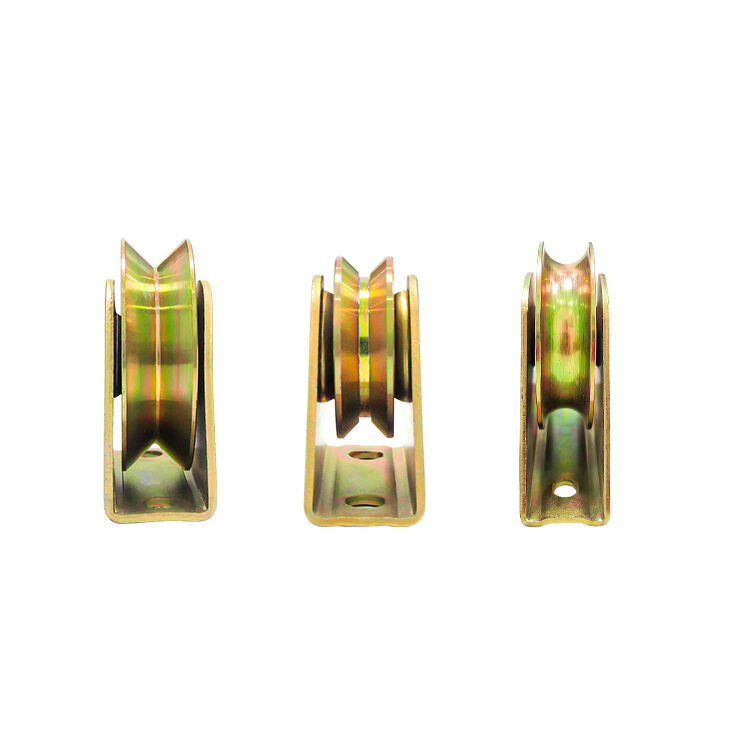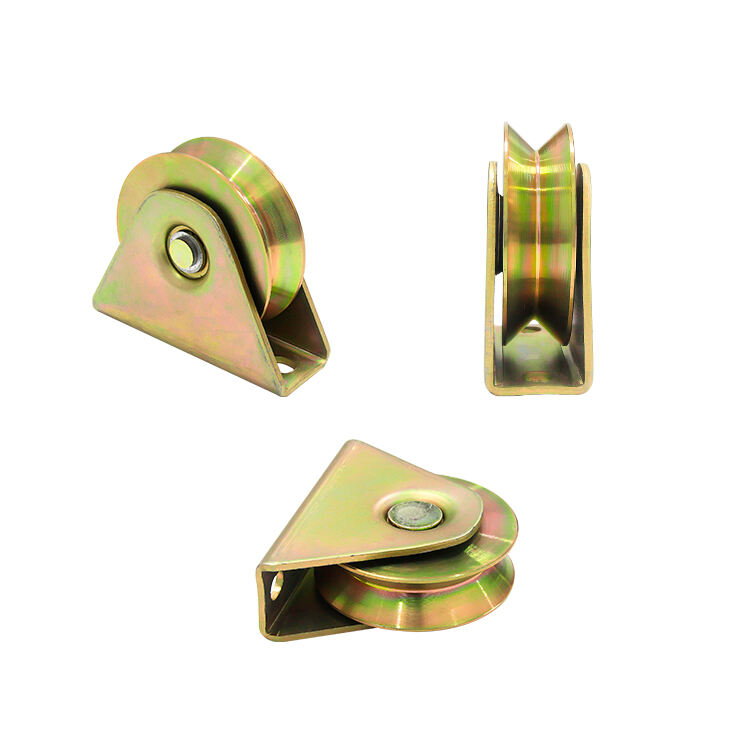Understanding Groove Wheel Mechanics and Types
How Groove Wheels Impact Sliding Gate Movement
Groove wheels play a key role in making sliding gates work properly. These little components sit between the gate and its track, cutting down on friction so the gate moves smoothly instead of getting stuck. When it comes to grooves themselves, deeper ones generally create less resistance than shallow ones, affecting how well the gate actually slides along. We've seen plenty of problems over the years when people install the wrong type of wheel for their particular gate setup. Gates start jamming up or moving really slowly because the wheels just aren't right for the job. That's why it matters so much to match the wheels with what the gate actually needs.
V-Groove vs U-Groove: Key Design Differences
Groove wheels come in two main types: V-groove and U-groove. The V-shaped cut on V-groove wheels gives them better direction control, making them great for tough jobs where accuracy matters most. On the flip side, U-groove wheels have wider grooves that spread weight around more evenly. This makes them work better when flexibility is needed rather than strict alignment. Most factories stick with V-grooves for big industrial gates since they need rock solid stability day after day. But homeowners often go for U-grooves on sliding gates because those gates need to move smoothly without getting stuck. Choosing the right type really affects how well a gate lasts over time. Gates with poor groove selection tend to need repairs sooner and generally don't last as long before replacement becomes necessary.
Cantilever Gate Wheel Requirements
Wheel selection matters a lot when it comes to cantilever gates because these structures don't sit on the ground like regular gates. The wheels need to carry all the weight as they roll along their tracks. Picking the right wheels depends heavily on where the gate will be installed. For outdoor setups especially, going with wheels built for rough surfaces and bad weather makes sense. Nobody wants their gate failing during a storm or getting stuck in muddy conditions. Most installers know that getting the size right and finding durable wheels really pays off in the long run. Gates last longer and work better when the wheels match both the load requirements and environmental factors at play.
Material Selection for Sliding Gate Wheels
Steel vs Stainless Steel: Corrosion Resistance
Corrosion resistance matters a lot when picking out materials for sliding gate wheels. Regular steel wheels might seem tough at first glance but tend to rust after sitting outside for months or years. Stainless steel options stand up better against weather damage because they contain chromium that creates a protective barrier against rust formation. Industry experience shows these stainless variants hold up much longer in harsh outdoor conditions, which explains why many installers prefer them for exterior gate applications. The material choice really affects how long the system lasts between repairs and replacements down the road.
Nylon Wheels for Quiet Operation
For people wanting quieter sliding gates, nylon wheels work really well. The composite material just seems to absorb some of the noise naturally, so things don't clatter as much when the gate moves. Another plus is that these wheels aren't heavy at all compared to metal ones, which makes installation a lot simpler too. Homeowners report feeling less annoyed by gate noise after switching to nylon, especially in neighborhoods where everyone tries to keep things peaceful. Plus, they last longer without wearing down as quickly, so gates continue running smoothly year after year without needing constant adjustments or replacements.
Load Capacity and Weight Distribution
When picking out sliding gate wheels, it's really important to get a handle on load capacity and make sure weights are distributed properly. Wheels need to be able to handle the actual weight of the gate plus how often it gets used throughout the day. If they don't match up right, we've seen cases where wheels just break down over time or gates start moving sluggishly. For bigger gates especially, going with wheels rated for higher loads makes all the difference in getting that smooth opening and closing action. Also worth noting is spreading the weight evenly among all those wheels. Uneven distribution tends to wear some parts out faster than others, which means shorter life for the whole gate system. Taking these things into account helps folks choose wheels that actually work well in practice rather than just looking good on paper.
Compatibility with Automated Gate Systems
Integrating Wheels with Sliding Gate Motors
Getting the right wheels for sliding gate motors matters a lot if we want these systems to perform well over time. Sliding gates just won't run smoothly without proper wheel-motor compatibility. Take those automatic sliding gate openers for commercial properties as an example they need wheels capable of handling heavy loads without wobbling or binding. When wheels don't match what the motor was designed for, the motor ends up working harder than necessary which shortens its lifespan and creates inconsistent gate operation. Anyone installing or maintaining these systems should pay close attention to three main factors: how much weight the gate actually carries, how often it gets used throughout the day, and what kind of weather conditions it faces regularly. Getting this right makes all the difference between a reliable system and one that breaks down constantly.
Heavy-Duty Wheels for Automatic Openers
When it comes to automatic gate openers, those heavy duty wheels really matter for how well everything works over time. They get slammed with daily usage from cars coming and going all day long, so they need to hold up against constant stress and strain. Most industry guidelines specify that these wheels should be built tough enough to handle serious weight without breaking down, plus keep things rolling smoothly without getting stuck. Take electric sliding gates for example the wheels there have strict requirements about how weight gets spread across them and just how durable they need to be before replacement becomes necessary. Getting this part right makes a big difference. Good quality wheels stop gates from getting out of alignment, cut down on how often repairs are needed, and basically make sure both the gate mechanism and the actual gate itself last much longer than cheaper alternatives would allow.
Electric Opener Alignment Considerations
Getting the alignment right between electric openers and wheel systems makes all the difference when it comes to smooth gate operation. When things get out of whack, we've seen gates derail completely or motors working themselves into an early grave. Regular checks of the wheel track go a long way toward keeping everything running properly. Look at the track surface first – does it sit level across its entire length? Then check those wheels: are they tight where they should be and sitting in their proper spots? We've had customers come in frustrated because a single loose wheel was causing weeks of headaches. Taking these basic steps not only keeps gates moving smoothly day after day but also saves money down the road by extending the lifespan of expensive parts like motors and wheels.
Installation and Maintenance Best Practices
Track Preparation for V-Groove Wheels
Getting tracks ready for those V-groove wheels takes some careful work if we want everything to run smoothly without issues down the road. Start by measuring the track width accurately so it matches up properly with the actual size of the wheels themselves. This makes sure they fit together just right when installed later on. Before putting anything in place though, give the whole track surface a good cleaning job. Get rid of all that dirt and grime because even small bits can cause problems when things are moving around. When actually installing these tracks, proper alignment matters a lot. If done correctly according to specs, this helps prevent extra wear and tear on both the tracks and the wheels over time.
Mistakes happen all the time with sliding gates, mostly because people get the alignment wrong or mismatch the wheels to the track size. This leads to all sorts of problems down the road. Take leveling as an example most folks forget how critical this step really is. When installers skip checking for a flat surface, gates tend to jerk around when moving, which is not only annoying but can actually damage components over time. Catching these errors before everything gets put together saves headaches later on and makes sure the whole system runs smoothly without constant adjustments needed after installation.
Lubrication Routines for Smooth Movement
Keeping those sliding gate wheels properly lubricated makes all the difference when it comes to smooth operation and how long they'll last. When picking out what kind of lube to use, there are some good choices on the market. Silicone based greases work well because they handle temperature changes pretty well, while lithium oils tend to stick around longer without breaking down. Most folks find that these products cut down on friction quite nicely too. If someone sticks to regular maintenance schedules, they'll notice less grinding noises and smoother gate movement over time. The wheels just don't wear out as fast when there's proper lubrication between them and the tracks where they roll along.
The type of material used for wheels really matters when it comes to picking the right lubricant. Steel wheels generally work best with thicker, heavier lubricants because they handle more wear and tear. Nylon wheels tell a different story though they need something much lighter that won't eat away at the material over time. Most maintenance folks recommend sticking to a regular lubrication routine, maybe once every half year or so depending on how busy the gate gets. This kind of maintenance helps avoid those annoying squeaks and keeps everything running smoothly without any unexpected jams or sticking problems. Sliding gates just don't perform well when neglected, so keeping up with this basic care makes all the difference in the long run.
Inspecting Wear Patterns on Grooves
Looking at how the wheel grooves are wearing down should be part of regular maintenance checks so problems don't get missed until they're too big to ignore. Most folks start with just a visual inspection first thing. Check those grooves carefully for anything out of place – maybe some areas look worn away more than others, there might be small cracks forming, or certain spots appear overly shiny from all that rubbing against the track. These little details tell a story about what's happening under the surface. For those who want numbers instead of guesswork, grabbing a good quality caliper makes all the difference. Measuring exactly how deep those grooves have become gives a much clearer picture of their condition than just eyeballing it ever could.
Wear patterns on sliding gate wheels actually tell a story about their condition. When we start seeing those telltale signs of wear that affect how smoothly things move, replacement becomes pretty much mandatory rather than optional. Most folks wait until they see visible damage before taking action, but regular checks every few months go a long way toward keeping everything running safely. The truth is, nobody wants to deal with emergency repairs during peak hours because worn out wheels failed unexpectedly. Look closely at those wheel grooves - once they've lost most of their original shape, it's definitely time for new ones. This simple maintenance step keeps gates operating without interruption while avoiding costly downtime later on.




